Click once or twice on the pictures to enlarge
I have owned slops, cutters, and schooners, three of them, but no ketches or yawls. I have nothing against ketches and yawls. I have been experimenting with different rigs and have changed my mind over the years as I have gained more experience and better knowledge.
Traditionally there were many small working boats with spritsails on the Swedish west coast. The bigger working boats had gaff sails. Yachtsmen tended to have Bermudan sails.
To support the sails you need masts. Bermudan sail need much taller masts than four corned sails about twice as high. Why do then sailboats use so Bermudan sails and tall masts?
There are two very different reasons. One is that a four corned sail needs an extra spar to spread out its canvas. On small boats that is no problem but as boats gets bigger and bigger the handling of that extra spar gets more and more difficult.
The second reason is racing rules. One would think that cruising men would disregard racing rules. Not so, a cruising sailboat is a very big investment. They often cost as much as a house therefore the buyer consider the resale value. A boat that can be raced has a higher value on the second hand market. Therefore even if the buyer never intends to race he invests in it. The next buyer also he considers the resale value and so on ad infinitum. Those even the second hand market ends up with boats that have bad properties that few cruising men are interested in
Racing rules do not even measure or calculate how fast a boat will sail. They measure speed producing elements, like sail area, waterline length, displacement, to name a few that are easy to measure and with a help of an arbitrary formula comes up with a number that is the rating. It is impossible to produce a fair sane formula for speed. Racing committees have tried it for hundreds of years. Sure racers need rules, but cruising men should not sail boats that are built to race. If you are concerned with money get a smaller boat, it is cheaper, it is good for nature, it lets you sail more often.
When you are racing the most important point of sailing is close hauled. At that point of sailing, the high aspect ratio sail is most efficient according to aerodynamics, but only if you compare equal sail area. If you instead measure mast length, high aspect ratio sails such as the Bermudan sail is much inferior. Had the rule makers instead measured mast length, the Bermudan rig would have been created, as it would never have won any race.
Never trust the grown ups. 1967 I sailed from Sweden to Limfjord Denmark with Anna. I had the Bermudan main up also I had an old spritsail. The wind died out I changed to the spritsail. To my great surprise she started to sail very much closer to the wind. The difference was really incredible after all I had read of how much better the Bermudan sail was supposed to be and the sprit did not even reach the masttop.
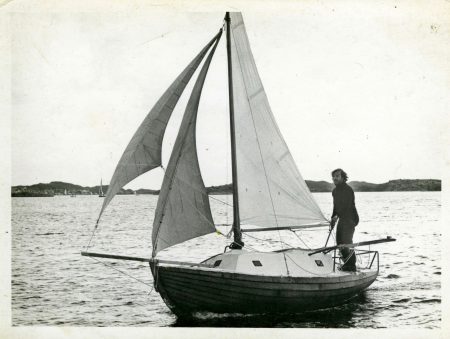
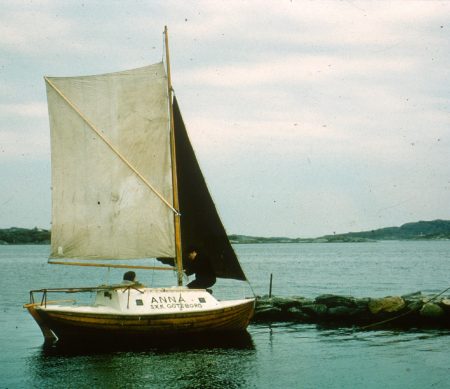
Just for fun belov Amfibie Bris 1988 with her spritrig
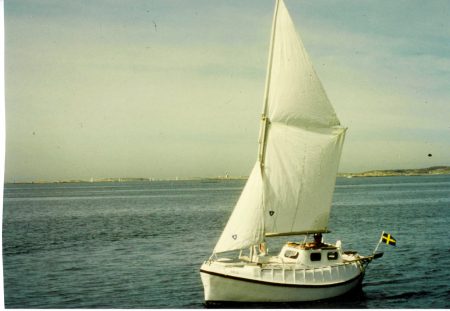
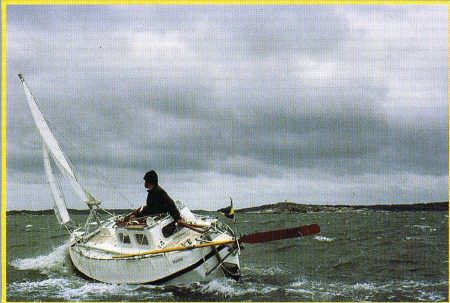
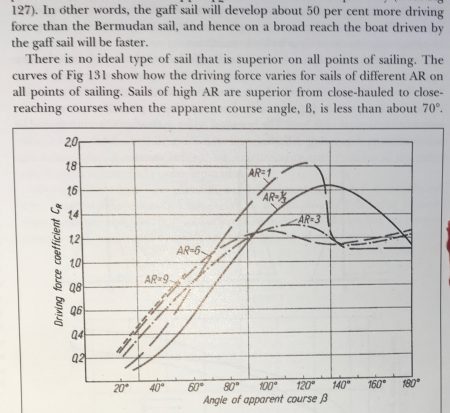
The science of aerodynamics is created and paid by the airplane industry. The science of airplanes is many times more advanced than that of yachts. Superficially a wing is a wing if it is attached to a boat or an airplane the science is the same – right – no wrong you cannot leave out the important question of stability.
A high aspect ratio wing is good engineering on an airplane but a disaster on a yacht. The reason is; the wing on a boat causes a healing moment. To counter that moment a yacht needs a ballast keel. On a top end racing boat that ballast is as heavy as the rest of the boat. It stands for 50 % of the total weight. That extra weight equals 50 % of the resistance, it can be substantially be reduced by lower aspect ratio sails.
On airplanes the healing effect of one wing is counterbalanced by the wing on the opposite side. That is why high aspect wing is good engineering on airplanes. There are no one-winged airplanes with a ballast keel on the opposite side.
To design a good cruiser it is important to se the whole picture, to take into account that cruisers sail a lot downwind and that stability is part of the picture and that it is important to reduce the amount of ballast and that the cargo carried by a cruiser adds to stability if it is carried low down.
The conclusion of the above is that it is advantages for a small cruiser to have a rig with a low center of effort. Rigs with sails that have four corners have much shorter masts and lower center of effort than those that have three corners. They have much lower healing moment and need much less stability. Today after much slow thinking and experimenting I have come to the conclusion that the balanced lugsail with a freestanding mast is the best for my boats. Here is why.
A short mast on a small boat can easily be designed to be freestanding. On a mast that has no shrouds and stays, the sail can pivot all the way forward if need be. This increases safety. That setup will let me spill the wind in a sudden squall. It will also let me reduce speed when docking. Obviously it also reduces chafe, as there is no shrouds that the sail can rub against.
The more you let out your sails on a downwind course the more stable is the configuration, the risks of gibes are reduced, the boat will also be more directional stable. Hence the sailing becomes more safe and pleasant.
Like the balanced rudder, the part of the sail in front of the mast “balances” the pressure of the wind on the sail. When tacking it catches the wind and helps the sail pivot across. When gybing it reduces the amount of force when the boom comes across. When running downwind it keeps the center of effort closer to the centerline of the boat reducing weather helm. The force on the sheet is very small. There is no need for winches and blocks. The rig is also self tacking, just put the helm a lee.
A third of the lugsails area is in front of the mast. In fact the French call it “voile au tiers” meaning “sail of thirds” or something like that. It is not a new idea birds invented it a long time ago. A third of the area of a birds feather is in front of the stem.
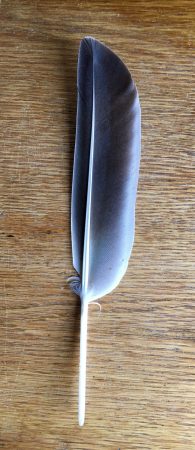
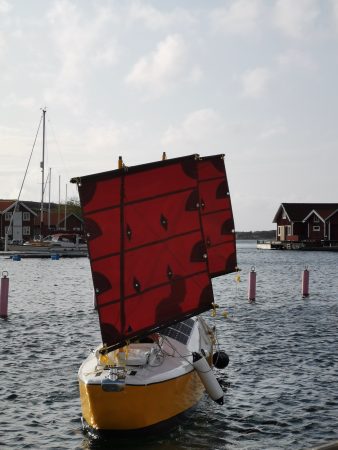
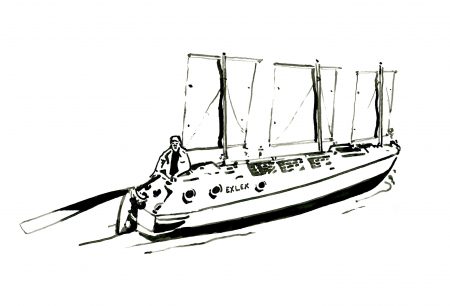
The downhaul of the lugsail is attached to the boom 20 % behind the luff. There is no metal fitting on the lugsail. There is no gooseneck attaching the boom to the mast, nor is there any slides attaching the sail to the mast or track on the masts. This makes the rig very cheap, simple rugged, robust and very easy to maintain. In fact Exlex masts are discarded Europe-dingy masts whose mast tracks or luff grooves was not intact.
A further advantage is that the position of the downhaul prevents the boom from lifting; there is those no need for a kicking strap or boom vang.
The mast interferes with the flow over the lugsail but there is nothing to disturb the flow over its luff. The Bermudan mainsail on the other hand has a mast in front of the luff that disturbs the airflow over the whole sail and that is particularly bad at the top of the sail, even the forestay disturbs the airflow over the jib.
It is imperative that the boat works well especially in bad storms. A short mast, as short as possible is a good start when designing a seaworthy cruiser.
For an equal sail area the lugsail gets away with a mast half as long a Bermudan sail needs.
A short mast has many advantages. If a mast is supported it will mostly fail in buckling. According to Eulers law if you shorten a mast to half its length it becomes 4 times as strong. This means tall masts affect stability badly.
Also a tall masts peripheral speed, the speed at the top of the mast is much higher than that of a short. That means that when the boat is capsized or pitchpoled it will hit the water with much higher speed.
Water is soft when you touch it slowly and gently but when you hit it with a fast mowing object it becomes very hard. You can waterski on it. In fact going fast enough you can waterski on your heels.
This combination of the above factors causes great danger to boats that capsize. Most often their masts break.
Should a small boat with a short mast capsize it is unlikely that anything will break.
Yeas storms can be bad to big boats. Still some sailors hate calms more than storms. The reason is that that big boats roll and the sails flaps. This after a long time can drive many hardy sailors completely nuts.
Not me. Not because I am more hard than other sailors. I love calms because I have a small boat and the sails of my boat do not flap and the boat does not roll and in a calm the weather is fine and I can go for a swim.
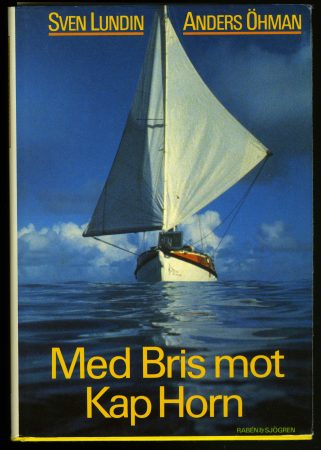
The reason is that my masts are short, my sails are small, my boat has flat bottom and no deep ballast keel. The Sargasso Sea is not for everyone but Exlex with her short masts thrives in calms and storms.
Racing rules penalizes sail area. If you are not racing do not limit your sail area. On a cruising boat there is no law against plenty of sail. Put up as much as your short mast can carry, just make sure that you can reduce it quickly.
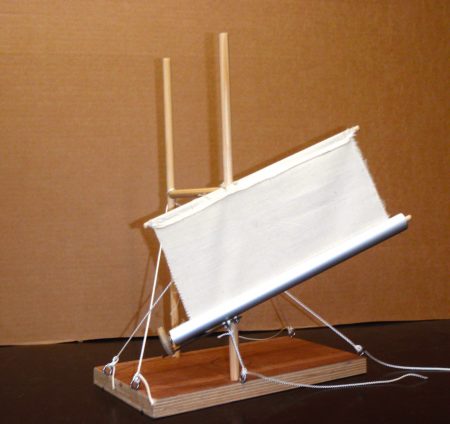
Most cruisers use autopilots and selfstearing apparatus. They complicate the boat and are in the way. Also they break down frequently. I prefer the old way as practiced by pioneers like Slocum and Voss.
Slocum rigged the Liberdade, a boat he built in Brazil and sailed to the US with his family, with three masts. The sails were in fact balanced lugsail with full length battens AKA junk sails.
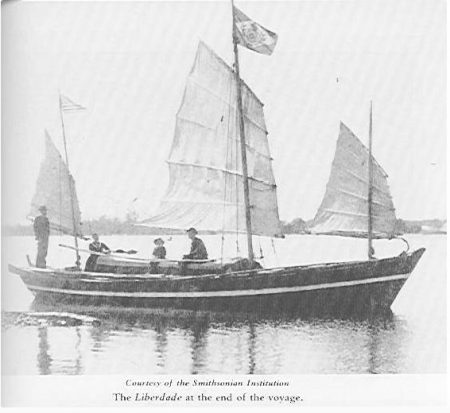
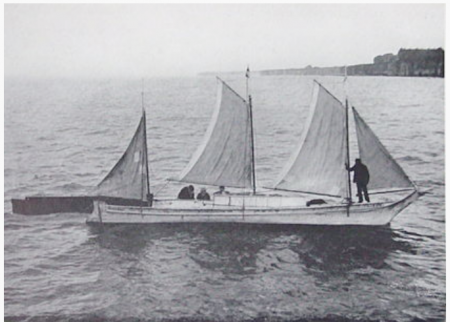
If you like my blog please support my project with a donation.
Regards Yrvind
